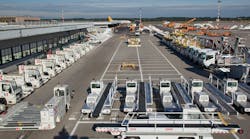Aug. 17 marks the 90th anniversary of the dedication of what is today known as the Charles B. Wheeler Downtown Airport. Because of its location at the confluence of the Kansas and Missouri rivers, the airport was originally called “Peninsula Field.” A celebration is being held and former City of Kansas City, Missouri Mayor Charles B. Wheeler Downtown will be on hand.
Charles Lindbergh dedicated the Kansas City Municipal Airport in 1927, less than three months after his historic solo crossing of the Atlantic Ocean. During his dedication speech, Lindbergh praised Kansas City, indicating that the city’s central location and the airport’s proximity to the business district gave the city the potential to become the air capital of the United States. Those strengths indeed became major factors in the airport’s success over the years.
In 1928, a passenger terminal was built for the transcontinental rail-air operations, and was run by Transcontinental Air Transport and Western Air Express. At the time, Lindbergh was an advisor and pilot for TAT. True to Lindbergh's prediction, by April 1929, Kansas City Municipal Airport was home to more passenger airlines than any other airport in the nation and had acquired the title, "Air Hub of America." It was given the Civil Aeronautics Board airport code “MKC”, presumably an abbreviation of “Municipal Kansas City.” TAT merged with Maddux Airlines and Western Air Express to become Transcontinental & Western Air, Inc., or TWA. When appointed to lead a committee to select TWA's World Headquarters, Lindbergh convinced the committee to choose Kansas City, setting the wheels in motion to position Kansas City as an aviation leader on a national scale. The original TWA headquarters, built in 1932, still stands today as Signature Flight Support. The TWA Museum is now housed in the building.
After World War II, commercial aviation in Kansas City flourished and growth continued into the 1950s with the construction of the Broadway Bridge. Renowned aviator and movie producer Howard Hughes, who was the principal shareholder in TWA from 1939 to 1960, was a frequent visitor to Kansas City Municipal Airport. Hughes was instrumental in persuading Lockheed to construct the four-engine Constellation or "Connie," and later, the Super Constellation, which could fly at a higher altitude, avoiding air turbulence and allowing faster cruise speeds. A restored 1958 Connie is presently on display with other historic aircraft at the National Airline History Museum located at Downtown Airport. Other historic aircraft on the field are owned by TriStar Experience, which has historic, flyable jet aircraft that it uses for educational and experiential programs to inspire students into STEM fields of study, as well as to pursue aviation and aerospace related careers.
By the 1960s, Municipal Airport could no longer accommodate the larger commercial planes and increased jet and passenger traffic. Plans for a new airport were developed and commercial air operations were transferred to a newly built Kansas City International Airport in November 1972. The Municipal Airport’s name was changed to Kansas City Downtown Airport in October 1977 and then again to Charles B. Wheeler Downtown Airport, in honor of the former mayor, in 2002.
Today at Charles B. Wheeler Downtown Airport up to 700 aircraft per day take off or land at the 695-acre facility - everything from single-engine propeller craft to sleek corporate jets. In the shadows of the Kansas City downtown skyline, the facility and its control tower are open 24 hours a day and consistently rank highly among private and corporate pilots for their full range of service to general aviation. Fixed-base operators service Atlantic Aviation and Signature Flight Support serve nearly 300 based aircraft, as well as itinerant and charter aircraft, offering fuel, full maintenance, aircraft rentals, sales and flight training. The Kansas City Aviation Department, which owns and operates the airport, built a general aviation complex with hangars, a terminal, ties downs and self-fuel avgas. Global advertising, marketing and interactive firm VML is housed in the former terminal building. Several other aviation tenants are housed at the airport.

